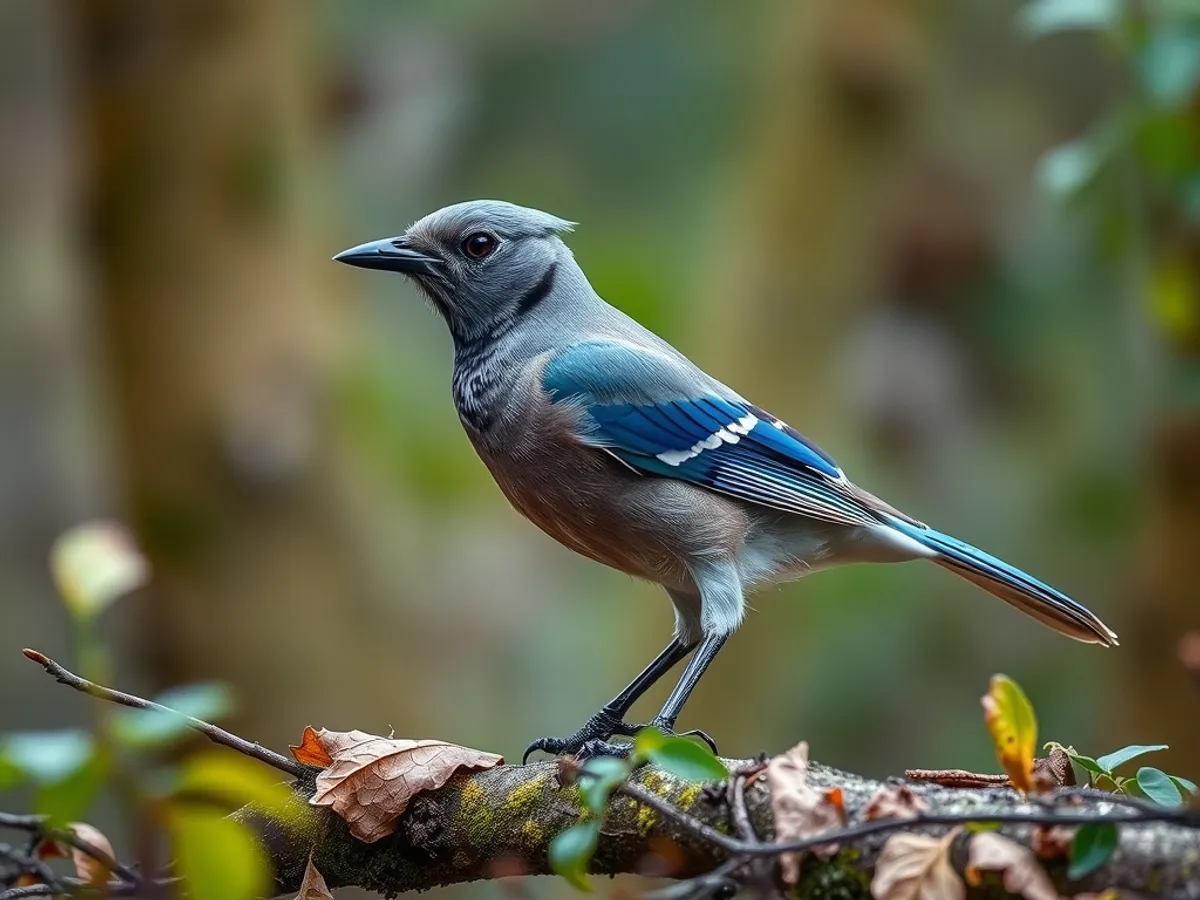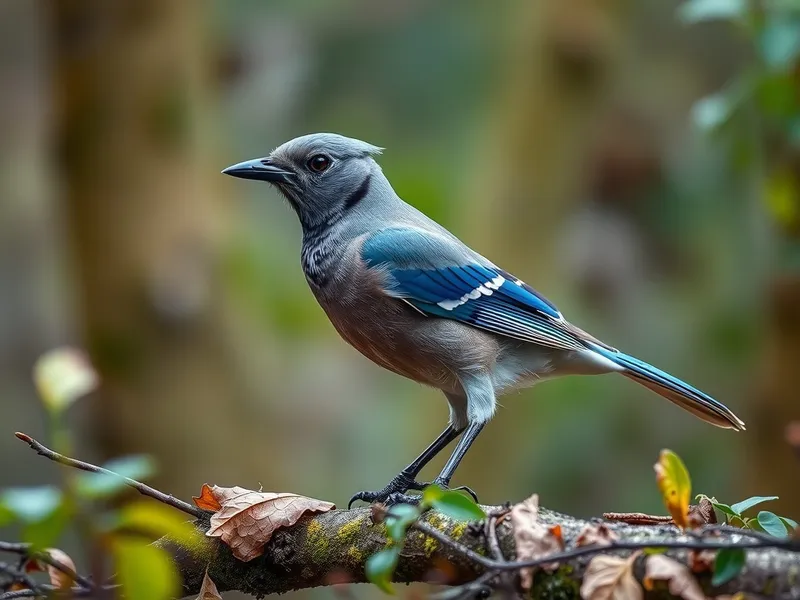
Eurasian Jay
Garrulus glandarius

Meet the Eurasian Jay
The Eurasian Jay is a striking and intelligent bird known for its pinkish-brown plumage, bright blue and black wing patches, and distinctive white rump. Native to woodlands across Europe and parts of Asia, this bird is often heard before it is seen, thanks to its harsh, screeching calls. It plays a vital ecological role by dispersing acorns, aiding oak tree regeneration, and is renowned for its remarkable memory. The Eurasian Jay is also highly adaptable, thriving in a variety of forested habitats and even urban parks.
Classification
Bird
Habitat
Deciduous and mixed woodlands
Diet
Omnivore
Lifespan
5-16 years
Conservation
Least Concern
Weight
140-190 g
📖Fascinating Facts
Expert Mimic
Eurasian Jays are skilled mimics, often imitating the calls of other birds, animals, and even human-made sounds.
Forest Regenerator
Their habit of burying acorns helps regenerate oak forests, making them vital to their ecosystem.
Colorful Feathers
The Jay's bright blue wing feathers are so unique they've been used in military and ceremonial hats in Europe.
📋Detailed Description
The Eurasian Jay (Garrulus glandarius) is a medium-sized corvid, typically measuring 32–35 cm in length with a wingspan of 52–58 cm and weighing between 140–190 grams. Its plumage is predominantly pinkish-brown, with a striking black moustachial stripe, white throat, and a conspicuous white rump visible in flight. The wings are marked with a vivid blue patch, barred with black, which is especially noticeable during flight or display. The tail is black, and the crown often shows fine black streaks. The bill is strong and slightly hooked, adapted for a varied diet. Eurasian Jays are known for their secretive behavior, often remaining hidden in dense foliage, but their harsh, rasping calls frequently reveal their presence. Highly intelligent, they exhibit advanced problem-solving abilities and are capable of complex vocal mimicry, including imitating other bird species and even human-made sounds. Their eyes are pale blue, and both sexes are similar in appearance, though males may be slightly larger. The species is highly adaptable, occupying a range of wooded habitats from mature deciduous and mixed forests to urban parks and gardens. Across their vast range, Eurasian Jays display considerable variation in plumage and vocalizations, with over 30 recognized subspecies grouped into eight major clades.
💡 Did you know?
A single Eurasian Jay can hide up to 5,000 acorns in one autumn, remembering the locations months later.
🔬Research & Sources
Wikipedia Summary
The Eurasian jay is a species of passerine bird in the crow family Corvidae. It has pinkish brown plumage with a black stripe on each side of a whitish throat, a bright blue panel on the upper wing and a black tail. The Eurasian jay is a woodland bird that occurs over a vast region from western Europe and north-west Africa to the Indian subcontinent and further to the eastern seaboard of Asia and down into south-east Asia. Across this vast range, several distinct racial forms have evolved which look different from each other, especially when comparing forms at the extremes of its range.
Last Modified: 4/9/2025
🎭Behavior & Social Structure
Eurasian Jays are diurnal and primarily sedentary, though some northern populations exhibit partial migratory behavior. They are omnivorous, with a diet dominated by acorns in autumn and winter, which they cache extensively for later consumption—a behavior critical for oak forest regeneration. Their diet also includes insects, small vertebrates, seeds, berries, and occasionally eggs or nestlings of other birds. Jays use their strong bills to crack nuts and dig up cached food. Socially, they are typically seen alone or in pairs, but may form small family groups outside the breeding season. They are territorial during breeding, defending their nesting area vigorously. Jays are highly vocal, using a range of calls for alarm, contact, and mimicry, and are known to use deceptive calls to distract competitors from food caches. Their daily routine involves foraging in the morning and late afternoon, with periods of rest and preening during midday.
👶Reproduction & Life Cycle
Breeding occurs from April to July, with regional variation. Eurasian Jays are monogamous, forming long-term pair bonds. Courtship involves mutual feeding and display flights. Nests are built by both sexes, typically in trees or large shrubs, and are constructed from twigs, roots, and lined with softer materials. The female lays 4–7 eggs, which are pale blue or greenish with brown speckles. Incubation lasts 16–19 days, performed mainly by the female, while the male provides food. Both parents feed the chicks, which fledge at about 19–23 days old. Fledglings remain dependent on parents for several weeks post-fledging. Jays may raise one or occasionally two broods per season, depending on food availability and climate.
🛡️Adaptations & Survival
Eurasian Jays exhibit several notable adaptations. Their strong, versatile bill allows them to exploit a wide range of food sources, while their exceptional spatial memory enables them to remember thousands of acorn cache locations for months. Their cryptic plumage and secretive habits help avoid predation, and their ability to mimic calls can deter predators or competitors. Jays are highly intelligent, demonstrating problem-solving, tool use in captivity, and social learning. Their seasonal caching behavior is a key evolutionary adaptation for surviving winter food shortages. The blue wing patch, unique among European corvids, may play a role in intraspecific communication and mate selection.
📚Research Sources
🎨Cultural Significance
The Eurasian Jay has featured in European folklore and mythology, often symbolizing resourcefulness, intelligence, and sometimes thievery due to its habit of stealing eggs or shiny objects. In some cultures, its striking blue feathers were used for decoration or in fly-fishing lures. The bird’s acorn-caching behavior has made it an emblem of foresight and planning in literature. In modern times, the Eurasian Jay is appreciated for its role in forest ecology and as a charismatic representative of native wildlife in conservation education.
🔬Recent Research & Discoveries
Recent research has focused on the Eurasian Jay’s cognitive abilities, particularly its capacity for episodic-like memory and theory of mind—understanding the intentions of conspecifics when caching or pilfering food. Studies have demonstrated that jays can plan for future needs and adjust their caching strategies based on the presence of observers, indicating advanced social cognition. Genetic analyses have clarified the relationships among the numerous subspecies, revealing historical patterns of range expansion and isolation. Ongoing research is examining the impact of urbanization on jay behavior and the ecological consequences of their acorn dispersal activities.
🎥Wildlife Videos

Things you need to know about JAYS!
The most colourful member of the crow family, Jays are becoming a more common sight in parks and gardens. With their bright ...
A Shot Of Wildlife

Jay Film
With its vibrant plumage and striking personality, the Eurasian jay captivates birdwatchers and nature lovers alike, weaving tales ...
The Wonders Of Nature

Eurasian Jay
Eurasian Jay #factoids #animals #nature #naturedocumentary #naturevideos #wildlife #wildlifedocumentary #wildlifevideos ...
Factoids

Eurasian Jay, bright blue-black stripes on wings, migrates into urban areas as forest habitat erodes
The Eurasian Jay is a crow with a length of 14 - 15 cm, a wingspan of 3 - 4 cm, and a weight of 0.16 - 0.17 lb. The forehead and ...
Blue Garden

Blue Jay Migration - Lake Superior - Michigan's Upper Peninsula
Having grown up in the lower peninsula and having Jays throughout the winter; I was not aware that the Jays migrated at all and ...
WildBlessings2U

Eurasian Jay - garrulus glandarius - #wildlife #birds #birdwatching #jay #eurasianjay
Eurasian Jay - garrulus glandarius* (#bird ) *Scientific Classification:* Kingdom: Animalia Phylum: Chordata Class: Aves Order: ...
Wildlife
🌍Habitat Information
The Eurasian Jay typically inhabits Deciduous and mixed woodlands environments. Eurasian Jays have adapted to their environments with specialized features and behaviors.
Primary Habitat:
Deciduous and mixed woodlands
More detailed habitat information will be available soon.
🛡️Conservation Status
The Eurasian Jay is currently classified as Least Concern. Conservation efforts are crucial for preserving this species for future generations.
Common Threats:
- 🏠Habitat loss and fragmentation
- 🌡️Climate change impacts
- 🎯Hunting and poaching
- 🏭Human-wildlife conflict
⚠️Threats & Conservation Challenges
Currently assessed as Least Concern by the IUCN, Eurasian Jays have stable populations across most of their range. However, they face localized threats from habitat loss due to deforestation, urbanization, and agricultural expansion. In some areas, persecution as nest predators or crop pests has occurred, though this is less common today. Climate change may alter food availability and breeding phenology, potentially impacting populations in the long term. Despite these challenges, their adaptability to human-altered landscapes and diverse diet have allowed them to thrive even in suburban environments. Monitoring is recommended in regions where habitat fragmentation is significant.
🔬Scientific Classification
Scientific Name
Garrulus glandarius
Classification Hierarchy
🔍 About Taxonomic Classification
Taxonomic classification is a hierarchical system used by scientists to classify and organize living organisms based on shared characteristics and evolutionary relationships.
The system moves from broad categories (Kingdom) to increasingly specific ones, with each animal's scientific name typically consisting of its Genus and species.
📝Community Notes
Share your observations and insights about the Eurasian Jay with our community of wildlife enthusiasts.
Join Our Community
Sign in to share your observations and connect with fellow wildlife enthusiasts.
Sign In to ContributeNo community notes yet
Be the first to share your observations about the Eurasian Jay!
Explore Eurasian Jay
Select a tab above to learn more about this amazing animal.
📸Photo Gallery
No photos available for this animal yet.
🌟Discover More Wildlife
Continue your journey of discovery with more fascinating animals from our database
